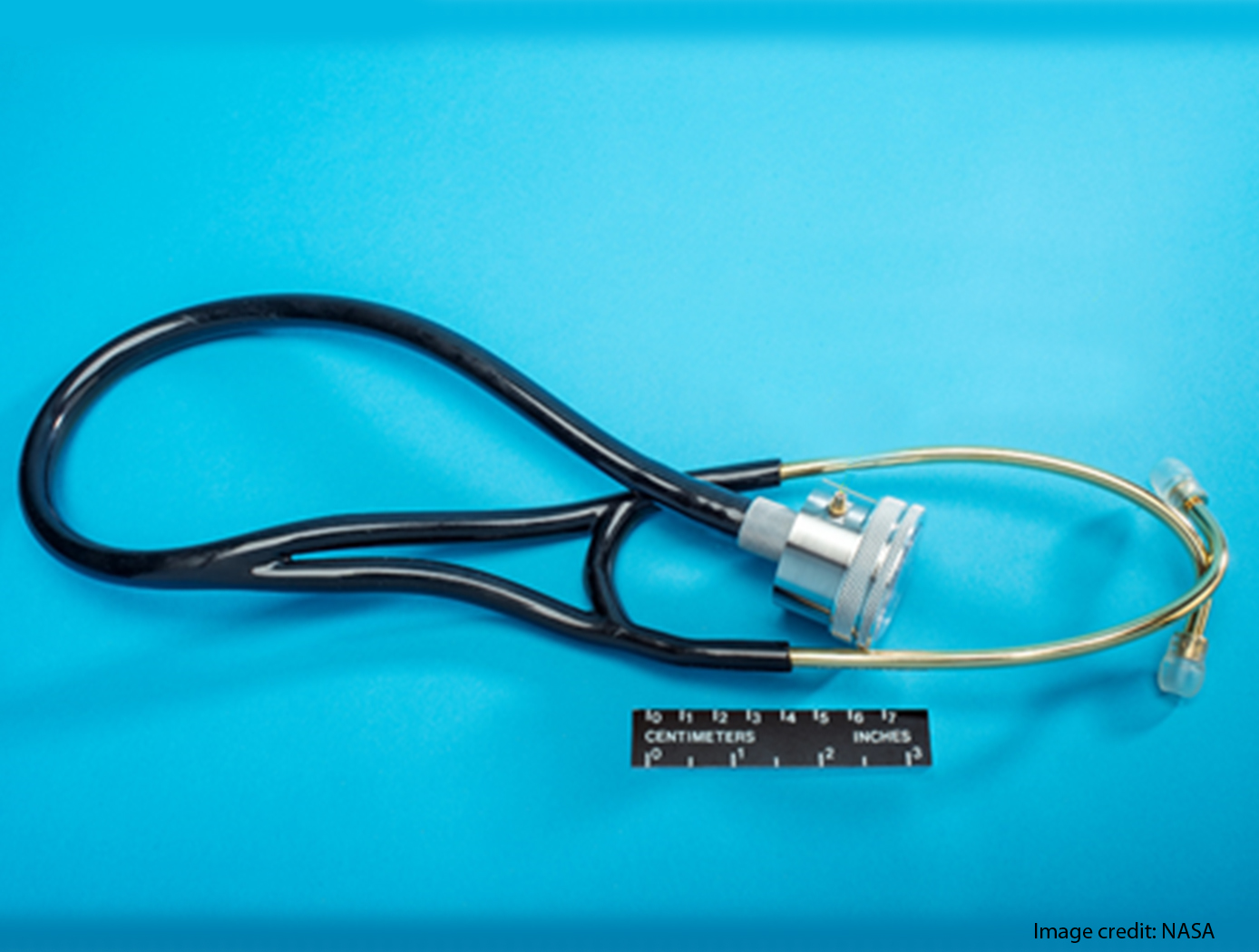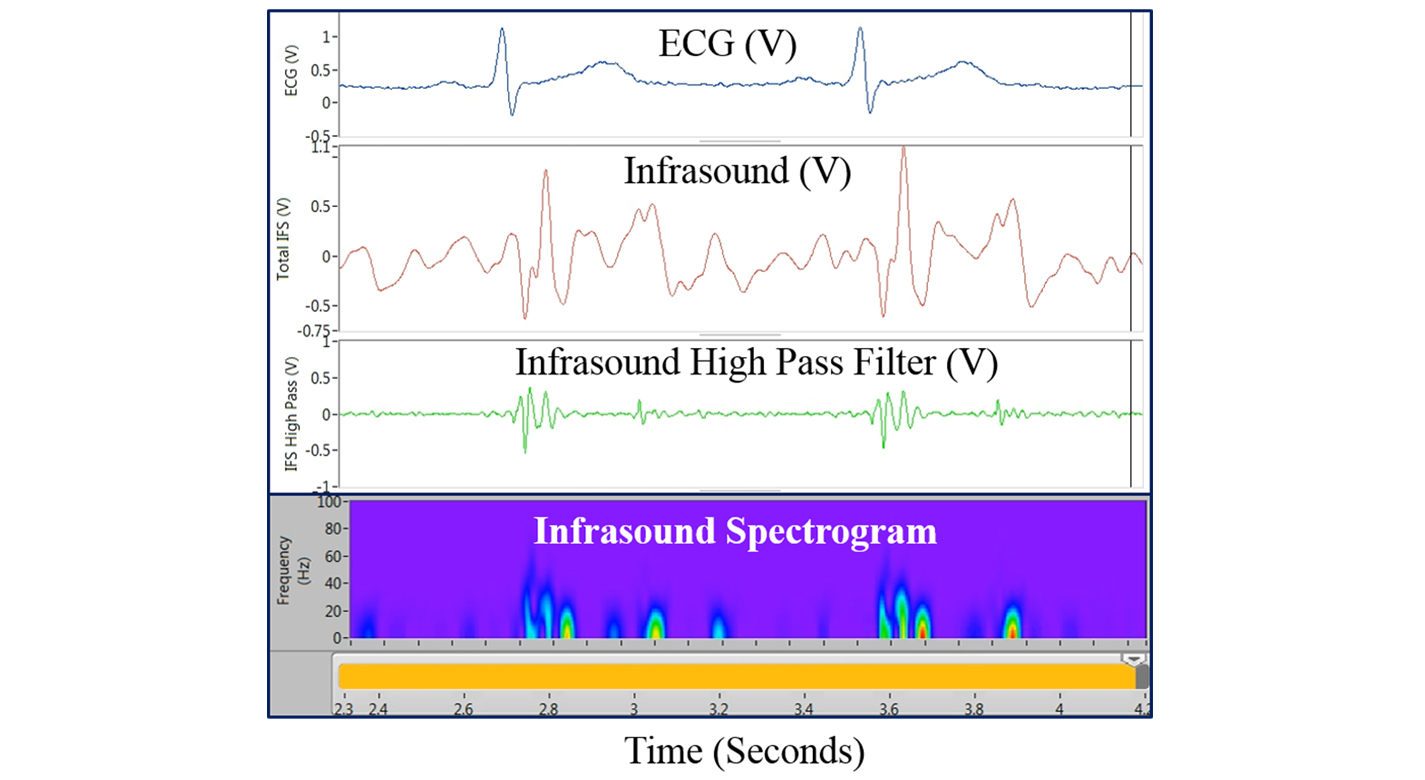Full Spectrum Infrasonic Stethoscope for Screening Heart, Carotid Artery, and Lung Related Diseases
Health Medicine and Biotechnology
Full Spectrum Infrasonic Stethoscope for Screening Heart, Carotid Artery, and Lung Related Diseases (LAR-TOPS-278)
Allow physicians to screen heart, carotid artery, and lung related diseases at an early stage using full spectrum phonocardiography
Overview
NASA Langley Research Center has developed an infrasonic stethoscope that detects a broader range of physiological conditions than conventional stethoscope, use of which has declined mainly due to availability of other advance technologies such as the echocardiogram. The echocardiograms can be complex, costly and require the need of a specialist for correct interpretation. Further, it is estimated that more than 85% population of the world does not have access to advanced diagnostic tools such as echocardiogram and CT scans. This scope provides additional data to physicians by monitoring signals across full frequency bandwidths that include cardiac, carotid artery, and respiration activities something that is not available in conventional stethoscopes.
The Technology
Microphones and stethoscopes are regularly used by physicians to detect sounds when monitoring physiological conditions. These monitors are coupled directly to a person's body and measure in certain bandwidths either by listening or by recording the signals. The physiological processes such as respiration and cardiac activity are reflected in a different frequency bandwidth from 0.01 Hz to 500 Hz. This technology can monitor physiological conditions in the entire bandwidth range. Signals can also be wirelessly transmitted, using Bluetooth, to other recording devices at any other location.


Benefits
- Can record heart, carotid artery, and lung sounds that cant be monitored by using a traditional stethoscope
- Measures systolic and diastolic time intervals
- Inexpensive alternative for screening of heart, carotid artery, and lung related diseases
- Provides real time fetal heart monitoring
Applications
- Cardiac and respiratory patient monitoring
- Emergency use by First Responders
- Fetal heart monitoring
- Spirometry
- Other medical uses where simultaneous respiratory and cardiac monitoring is critical
Technology Details
A Portable Infrasonic Detection System, Qamar A. Shams, Cecil G. Burkett, Allan J. Zuckerwar, Christopher C. Lawrenson, and Michael Masterman, 2008 Meeting of the Military Sensing Symposia (MSS) Specialty Group on Battlespace Acoustic and Seismic Sensing, Magnetic and Electric Field Sensors, August 19-21, 2008, https://ntrs.nasa.gov/citations/20080034649.
Similar Results

Remote, Noninvasive, Cardiac Activity Tracer (RENCAT)
Blood circulation carries vibrations due to heart beat to every part of the body. These vibrations result in minute displacements that are measured by the detector. Defective closures lead to backflow of blood into chambers leading to heart beat slowdown. Displacement strength is indicative of vibration strength which in turn is indicative of heart beat. Weak vibrations at toes, for example, indicate poor circulation of blood as in the case of diabetic issues. Similarly, in other parts of the body, this unit would help in early detection of diabetes and other diseases by noninvasively monitoring blood circulation at various regions of a human body. As such, this unit would detect precursors for diseases. For astronauts and other operatives, this device could remotely provide the status of their cardiac cycles during physical activities.
The device consists of a laser transmitter, photo-EMF detector and interferometric architecture which provides motion detection. Motion detection aids in measuring displacements. There is also a "speckle tolerant" property allowing data to be collected from conformal and rough target surfaces such as garments. Surface preparation is not needed such as in ECG and other cases. The novel Photo-EMF detector will be able to measure displacements of less than 1 pm.

Infrasound Sensor Technology
Large aircraft can generate air vortices in their wake, turbulence that can prove hazardous to aircraft that follow too closely. Because wake vortices are invisible, all takeoffs at busy airports are spaced several minutes apart. This separation gives the vortices time to dissipate, even though they only occur 10% of the time, with resulting loss of operational efficiency. Similarly, clear air turbulence is invisible and can also be hazardous to aircraft. By detecting such disturbances through their infrasound emissions, precautions can be taken to avoid them.
Other phenomena can be detected through infrasound, including tornadoes, helicopters on the other side of mountains, underground nuclear explosions and digging tunnels. Through the unique properties of infrasound, many of these can be detected from hundreds of miles away. NASA's infrasound sensor is a highly refined microphone that is capable of detecting acoustic waves from 20 Hz down to dc, the infrasound range. The design is robust and compact, eliminating the bulk and weight found in other technologies. Where most alternative methods are restricted to certain weather conditions and locations,
the NASA sensor filters noise from wind and other sources, allowing its use under any weather or geographic conditions.

Portable Medical Diagnosis Instrument
The technology utilizes four cutting-edge sensor technologies to enable minimally- or non-invasive analysis of various biological samples, including saliva, breath, and blood. The combination of technologies and sample pathways have unique advantages that collectively provides a powerful analytical capability. The four key technology components include the following: (1) the carbon nanotube (CNT) array designed for the detection of volatile molecules in exhaled breath; (2) a breath condenser surface to isolate nonvolatile breath compounds in exhaled breath; (3) the miniaturized differential mobility spectrometer (DMS) -like device for the detection of volatile and non-volatile molecules in condensed breath and saliva; and (4) the miniaturized circular disk (CD)-based centrifugal microfluidics device that can detect analytes in any liquid sample as well as perform blood cell counts. As an integrated system, the device has two ports for sample entry a mouthpiece for sampling of breath and a port for CD insertion. The breath analysis pathway consists of a CNT array followed by a condenser surface separating liquid and gas phase breath. The exhaled breath condensate is then analyzed via a DMS-like device and the separated gas breath can be analyzed by both CNT sensor array again and by DMS detectors.

Digital to Analog Transformation and Reconstruction of ECG Data
NASA innovators developed a method and apparatus for digital to analog conversion and reconstruction of multichannel electrocardiograms. The technology uses an algebraically optimized hardware configuration and software format that re-creates the presence of a connected patient when the patient is no longer actually present. This simplified method makes it easier and possible to transmit stored digital ECG data collected on one machine into another for an automated second opinion. Along with this functionality, the technology would make it possible to share the data collected for difficult-to-interpret 12-lead ECGs and rhythms with others in different locations.
The device allows for very inexpensive ECG hardware front ends to be utilized for data collection since the digital data obtained will always be accurately convertible back to analog for fuller analysis at any central ECG receiving station. This capability would be useful for several situations, such as patients being monitored for heart conditions at home, student athletes participating in ECG screening programs, and individuals being screened in underdeveloped countries or remote areas. The NASA developed technology would be useful in collecting ECG data in environments such as military mobile units, oil platforms, mountaineering, and expeditions.
This NASA Technology is available for your company to license and develop into a commercial product. NASA does not manufacture products for commercial sale.

Low Frequency Portable Acoustic Measurement System
Langley has developed various technologies to enable the portable detection system, including:
- 3-inch electret condenser microphone - unprecedented sensitivity of -45 dB/Hz
- compact nonporous windscreen - suitable for replacing spatially demanding soaker hoses in current use
- infrasonic calibrator for field use - piston phone with a test signal of 110 dB at 14Hz.
- laboratory calibration apparatus - to very low frequencies
- vacuum isolation vessel - sufficiently anechoic to permit measurement of background noise in microphones at frequencies down to a few Hz
- mobile source for reference - a Helmholtz resonator that provides pure tone at 19 Hz
The NASA system uses a three-element array in the field to locate sources of infrasound and their direction. This information has been correlated with PIREPs available in real time via the Internet, with 10 examples of good correlation.



